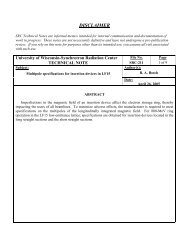SRC Users' Meeting - Synchrotron Radiation Center - University of ...
SRC Users' Meeting - Synchrotron Radiation Center - University of ...
SRC Users' Meeting - Synchrotron Radiation Center - University of ...
Create successful ePaper yourself
Turn your PDF publications into a flip-book with our unique Google optimized e-Paper software.
MOMENTUM DEPENDENT LOW ENERGY LOSSES IN CORE<br />
LEVEL PHOTOEMISSION SPECTRA OF POORLY CONDUCTING<br />
METALS?<br />
Hartmut Höchst and Christian R. Ast<br />
<strong>Synchrotron</strong> <strong>Radiation</strong> <strong>Center</strong>, <strong>University</strong> <strong>of</strong> Wisconsin-Madison<br />
3731 Schneider Drive, Stoughton, WI, 53589<br />
The availability <strong>of</strong> high-quality samples having low impurity levels and good<br />
structural quality combined with instrumental improvements in synchrotron radiation<br />
beam lines and electron energy analyzers <strong>of</strong> high energy resolution led recently to<br />
photoemission core-level spectra exhibiting additional features which were previously<br />
not seen. Photoemission line-shape changes or multiple core-level components can occur<br />
through surface modifications, crystal-field splitting, vibrational contributions and<br />
excitations <strong>of</strong> electrons or phonons. [1] The theory <strong>of</strong> core-level photoemission and<br />
aspects <strong>of</strong> intrinsic and extrinsic excitations associated with the photo-hole, or<br />
photoelectron, were recently restated in a series <strong>of</strong> papers by Hedin and coworkers.[2]<br />
The relative strength <strong>of</strong> low energy excitations accompanying the “main line”<br />
photoemission spectrum is directly related to the dc resistivity and can be quite<br />
significant in materials <strong>of</strong> poor conductivity such as small-gap superconductors and<br />
semimetals.[3]<br />
We report angle resolved core-level photoemission spectra <strong>of</strong> the semimetals Sb<br />
and Bi where we observe a multiple peak structure separated by ~170-300 meV towards<br />
higher energy from the main 4d and 5d components, respectively.[4,5] Utilizing photons<br />
ranging from 30-150 eV, angular scans along the k-direction normal to the (111) surface<br />
and k || scans along high symmetry directions <strong>of</strong> the surface Brillouin-zone (SBZ), we find<br />
dispersion in the split-<strong>of</strong>f components commensurate with the bulk and surface Brillouinzone<br />
periodicity. Additionally, the peak width and intensity <strong>of</strong> the split-<strong>of</strong>f peak oscillates<br />
between final state symmetry points.<br />
From the wealth <strong>of</strong> accumulated information, we dismiss an earlier claim by<br />
Patthey et al. assigning the additional feature in the Bi 5d spectra to a surface- shifted<br />
component.[6] Since the d 5/2 and d 3/2 components show the same features symmetry<br />
arguments rule out crystal-field effects as the source <strong>of</strong> the observed peak splitting. The<br />
data can be explained by a k-dependent loss function consisting <strong>of</strong> several characteristic<br />
direct and indirect low energy interband transitions excited in various parts <strong>of</strong> the bulk<br />
Brillouin zone.<br />
Acknowledgements<br />
The <strong>Synchrotron</strong> <strong>Radiation</strong> <strong>Center</strong> (<strong>SRC</strong>) is funded by the National Science Foundation<br />
(NSF) under Grant No. DMR-0884402.<br />
References<br />
[1] J. N. Andersen, T. Balasubramanian, C.-O. Almbladh, et al., Physical Review Letters<br />
86, 4398 (2001).<br />
[2] L. Hedin and J. D. Lee, Physical Review B 64, 115109 (2001).
















